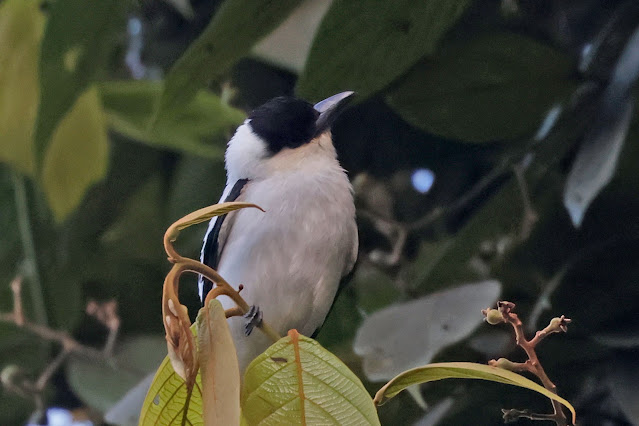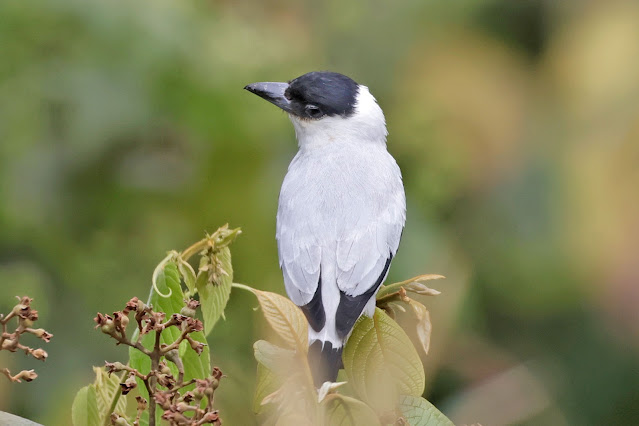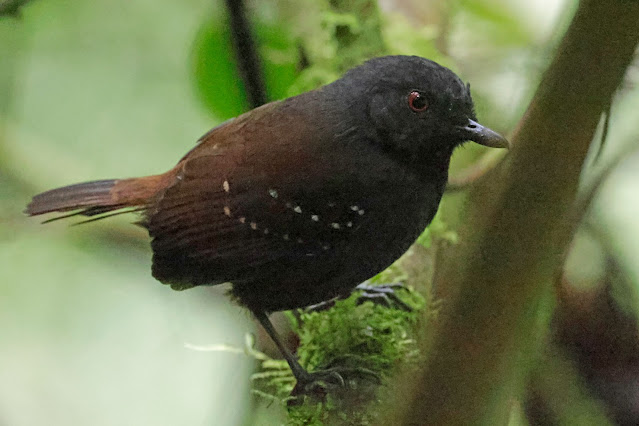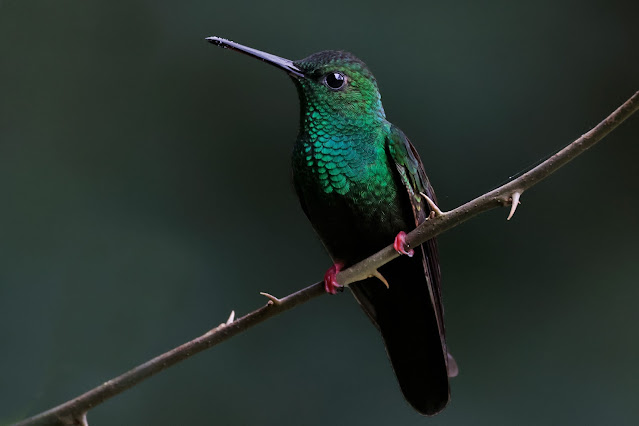We awoke, once again, before dawn, but this morning it was dry and there were clear breaks in the clouds all around us as we walked to the balcony. The sun was just rising sending some golden light across the sides of the distant valley.
The bird life became active very quickly, this a Tennessee Warbler in the tree tops. Another Nort American winter visitor.
The first risers are always the hummingbirds, the need to fuel up as soon as possible to maintain their high speed life styles. You can hear them buzzing around before actually seeing them. This is a Green Thorntail, one of the specialties here at Rancho Naturalista.
After watching from the balcony for awhile, with many of the birds seen previously present, our guide took us out around the gardens. Overhead in the trees was an Olive-sided Flycatcher.
And with them two White-fronted Parrots.
We walked down the hill and stopped in a clear area just pass the horse fields. The guide spotted a Band-tailed Barbtail, another hummingbird special to the area. Unfortunately it didn't stay around for a photograph, we will try again. There was a lot of activity around the clearing, special was this Black-crowned Tityra, a male. They were originally included in the flycatcher family, but now have separated into a family along with Becards and Cotingas
Another North American warbler, the Blackburnian Warbler.
Yesterday, there was a female Baltimore Oriole about, this morning a smart male put in an appearance.
The female Black-crowned Tityra.
And some more views of the male.
Walking back a Tropical Kingbird above the lodge.
And in the car park area a very nice Yellowish Flycatcher.
During breakfast a male Snowcap was around the verbena and I was able to get the first good view.
After breakfast a we set off on to the trails walking past the chalets and up through forest. We were heading for the pastures, an area of clearing where it is possible to view the edges of the trees and bushes. A Keel-billed Toucan was high in the trees.
There are two Toucan species in Costa Rica, the Yellow-throated which is found on the Pacific slopes, and thi the Keel-billed Toucan with the colourful bill.
As we came into the open a male Green Thorntail was perched on a dead branch.
The Thorntail has blue tail feathers.
A Crested Guan taking in the sunshine. Despite their these chicken-like birds are quite arboreal often being seen feeding on the fruit in trees, they can also fly very well.
The area was very active with plenty of birds. A Boat-billed Flycatcher in a nearby tree.
An the rarer Tody, the Black-capped Tody Flycatcher.
Another manakin, this time the White-ruffed Manakin.
A very smart looking Green Honeycreeper, this is the female, the male a little more bluish green, so not sure where the name came from.
The White-shouldered Tanager.
Another Tennessee Warbler.
It seemed like birds were all around us. This is a Brown-hooded Parrot.
A lovely pose from this butterfly. It is an Actinote Guatemalan.
There are two species of Tityra and we had seen one earlier, now the second appeared, the Masked Tityra, this the male, with the red face mask.
And the female.
Plus a male Black-crowned Tityra to complete the set.
One of the North American warblers I wanted to find was the Golden-winged Warbler. I managed a glimpse of one from the balcony yesterday, but no photograph, this morning one showed very well at the Pastures.
I never saw one when we lived in New Jersey, but I have seen one before, that was in 1988 in a housing estate in Larkfield, Kent, not far from where my daughter lives today. That was an incredible twitch with birders running around the estate peering into garden. I had a photograph I bought at Nancy's Cafe, but it was wonderful to get these shots of this stunning bird.
The view from the Pastures.
We went back into the forest where our guide was keen to show us some of the birds that live on the forest floor. There are many families that live in the dark, Wrens, Leaftossers and Antbirds. All are very vocal and normally that is the only clue of them being around.
Our guide picked up the call of a Dull-mantled Antbird, and by staying still and following the call we were able to get close. It was dull and required an ISO of around 32,000, so the images were sharp, but good enough to capture this bird of the forest floor.
It sings a series of eight sharp, high emphatic whistled notes, and can be told from other antbirds by the red iris and white spots on the shoulders.
Walking back we came across this Glasswing, still to be identified.
We made our way back to Lisa's House and garden where there was another Black-crested Coquette, but it didn't stay, the view though wasn't going anywhere, with the Turrialba Volcano away in the distance.
a closer view of the volcano crater, there are two, you can see one on with white charring on the left hand side.
We were keen to see if we could find the Band-tailed Barbtail seen earlier, so we made our way to the garden of Harry's House. Unfortunately there were no hummingbirds, but a very nice Juliet butterfly.
Our tour ended with lunch, but at Rancho Naturalista there are always birds about, so we returned to the balcony.
A Crowned Wood Nymph male.
The male Bronze-tailed Plumeleteer, with the pink red legs.
A Rufous-tailed Hummingbird.
There were Collared Aracari feeding in the trees above us. Love the way they slowly move their heads to be able to pick out the most suitable berries
Another hummingbird species around the verbena, a Strip-throated Hermit, another small hummingbird that is quite distinctive.
A male Violet-headed Hummingbird.
The one bird I wanted to photograph had so far eluded me, the male Snowcap. They only feed around the verbena and I could see them from the balcony, but it was difficult getting on to them. I decided to go down and watch from the ground and Helen guided me from above on the balcony. This proved to be quite successful.
The male is instantly recognisable.
It is uncommon on the Caribbean slopes but this is a very regular spot to see them and they are quite spectacular.
So it was a case of making up for lost time.
This one is my favourite.
And an acceptable flight shot.
Back up on the balcony there was late afternoon drama, when one of the many Red-billed Pigeons was taken by a Bicoloured Hawk. The Chachalacas went crazy and I rushed to the balcony to look, and saw the hawk cowling over the pigeon. It was gone before I could get the camera, but once it was gone the garden was quiet around the feeding stations.
The hummingbirds though continued to feed and here a late afternoon silhouette of a male White-necked Jacobin.
A successful day and one that stayed relatively dry, although the rain did return in the evening. Tomorrow we move on to Arenal, but we will have time for some more birding in the morning before pick up.
The trip list now stands at 83 with the lifers at 25









_MG_5613.jpg)












































_MG_6356.jpg)


















No comments:
Post a Comment